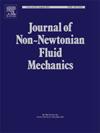Laminar planar jets of elastoviscoplastic fluids
IF 2.8
2区 工程技术
Q2 MECHANICS
引用次数: 0
Abstract
We perform numerical simulations of planar jets of elastoviscoplastic (EVP) fluid (Saramito (2007) model) at low Reynolds number. Three different configurations are considered: EVP jet in EVP ambient fluid, EVP jet in Newtonian ambient fluid (miscible), and EVP jet in Newtonian ambient fluid (immiscible). We investigate the effect of the Bingham number, i.e. of the dimensionless yield stress of the EVP fluid, on the jet dynamics, and find a good agreement with the scaling for laminar, Newtonian jets for the centerline velocity and for the jet thickness at small Bingham number. This is lost once substantial regions of the fluid become unyielded, where we find that the spreading rate of the jet and the decay rate of the centerline velocity increase with the Bingham number, due to the regions of unyielded fluid inducing a blockage effect on the jet. The most striking difference among the three configurations we considered is the extent and position of the regions of unyielded fluid: large portions of ambient and jet fluids (in particular, away from the inlet) are unyielded for the EVP jet in EVP ambient fluid, whereas for the other two configurations, the regions of unyielded fluid are limited to the jet, as expected. We derive a power law scaling for the centerline yield variable and confirm it with the results from our numerical simulations. The yield variable determines the transition from the viscoelastic Oldroyd-B fluid (yielded) to the viscoelastic Kelvin–Voigt material (unyielded).
弹塑性流体的层状平面射流
我们对低雷诺数下弹性粘塑性(EVP)流体(Saramito(2007)模型)的平面射流进行了数值模拟。我们考虑了三种不同的配置:(i) EVP 环境流体中的 EVP 喷射;(ii) 牛顿环境流体(混溶)中的 EVP 喷射;(iii) 牛顿环境流体(不溶)中的 EVP 喷射。我们研究了宾厄姆数(即 EVP 流体的无量纲屈服应力)对射流动力学的影响,发现在宾厄姆数较小时,中心线速度 uc/u0∝(x/h)-1/3 和射流厚度 δmom/h∝(x/h)2/3 与层流牛顿射流的缩放比例非常一致。我们发现,由于未屈服的流体区域对射流产生了阻塞效应,射流的扩散率和中心线速度的衰减率随宾汉数的增大而增大。我们所考虑的三种配置之间最显著的区别在于未屈服流体区域的范围和位置:在 EVP 环境流体中,EVP 喷射流体的大部分环境流体和喷射流体(尤其是远离入口处的部分)都是未屈服的,而在其他两种配置中,未屈服流体区域仅限于喷射流体,正如所预期的那样。我们推导出了中心线屈服变量的幂律比例,并与数值模拟结果相吻合。屈服变量决定了从粘弹性 Oldroyd-B 流体(屈服)到粘弹性 Kelvin-Voigt 材料(未屈服)的过渡。
本文章由计算机程序翻译,如有差异,请以英文原文为准。
求助全文
约1分钟内获得全文
求助全文
来源期刊
CiteScore
5.00
自引率
19.40%
发文量
109
审稿时长
61 days
期刊介绍:
The Journal of Non-Newtonian Fluid Mechanics publishes research on flowing soft matter systems. Submissions in all areas of flowing complex fluids are welcomed, including polymer melts and solutions, suspensions, colloids, surfactant solutions, biological fluids, gels, liquid crystals and granular materials. Flow problems relevant to microfluidics, lab-on-a-chip, nanofluidics, biological flows, geophysical flows, industrial processes and other applications are of interest.
Subjects considered suitable for the journal include the following (not necessarily in order of importance):
Theoretical, computational and experimental studies of naturally or technologically relevant flow problems where the non-Newtonian nature of the fluid is important in determining the character of the flow. We seek in particular studies that lend mechanistic insight into flow behavior in complex fluids or highlight flow phenomena unique to complex fluids. Examples include
Instabilities, unsteady and turbulent or chaotic flow characteristics in non-Newtonian fluids,
Multiphase flows involving complex fluids,
Problems involving transport phenomena such as heat and mass transfer and mixing, to the extent that the non-Newtonian flow behavior is central to the transport phenomena,
Novel flow situations that suggest the need for further theoretical study,
Practical situations of flow that are in need of systematic theoretical and experimental research. Such issues and developments commonly arise, for example, in the polymer processing, petroleum, pharmaceutical, biomedical and consumer product industries.

 求助内容:
求助内容: 应助结果提醒方式:
应助结果提醒方式:


